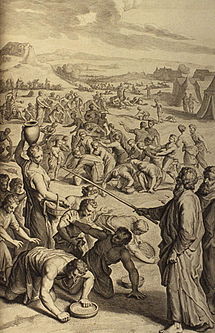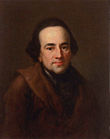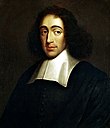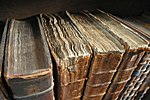Beshalach
[4] The parashah is notable for the Song of the Sea, which is traditionally chanted using a different melody and is written by the scribe using a distinctive brick-like pattern in the Torah scroll.
[19] Moses did so, and God drove back the sea with a strong east wind, and the Israelites marched through on dry ground, the waters forming walls on their right and left.
Deuteronomy 5:12–15 commands that one observe the Sabbath day, keep it holy, and not do any manner of work or cause anyone under one's control to work—so that one's subordinates might also rest—and remember that the Israelites were servants in the land of Egypt, and God brought them out with a mighty hand and by an outstretched arm.
The parashah has parallels or is discussed in these early nonrabbinic sources:[57] 1 Maccabees 2:27–38 told how in the 2nd century BCE, many followers of the pious Jewish priest Mattathias rebelled against the Seleucid king Antiochus IV Epiphanes.
[67] Citing Exodus 13:19, the Tosefta taught that just as "Moses took the bones of Joseph with him" into the Levites' camp, so one who was impure by reason of corpse contamination—and even a corpse—could enter the Temple Mount.
[68] A Midrash illustrated a precept to finish what one starts by citing how Moses began performing a commandment by taking the bones of Joseph with him, as Exodus 13:19 reports, but failed to complete the task.
"[69] Rabbi Jose the Galilean taught that the "certain men who were unclean by the dead body of a man, so that they could not keep the Passover on that day" in Numbers 9:6 were those who bore Joseph's coffin, as implied in Genesis 50:25 and Exodus 13:19.
The Israelites cast away all their Egyptian abominations, repented sincerely, and called upon God, as Exodus 14:10 reports, "And when Pharaoh drew near, the children of Israel lifted up their eyes."
"[77] In a Baraita, Rabbi Judah taught that the Israelites tried God with ten trials: two at the sea, two with water, two with the manna, two with the quail, one with the Golden Calf, and one in the wilderness of Paran.
Then Naḥshon ben Aminadab stepped forward and went into the sea first, praying in the words of Psalm 69:2–16, "Save me O God, for the waters come into my soul.
"[88] The school of Rabbi Ishmael reasoned from the meaning of the word "in the midst" (בְּתוֹךְ, be-tokh) in Exodus 14:22 to resolve an apparent contradiction between two Biblical verses.
Pharaoh concluded that the Egyptians should afflict the Israelites with water, because as indicated by Isaiah 54:9, God had sworn not to bring another flood to punish the world.
[107] The Gemara counted Exodus 15:18, "The Lord shall reign for ever and ever," among only three verses in the Torah that indisputably refer to God's Kingship, and thus are suitable for recitation on Rosh Hashanah.
A Baraita taught at the school of Rabbi Eliezer ben Jacob said that wherever Scripture employs the expression נֶצַח, nezach; סֶלָה, selah; or וָעֶד, va'ed; the process to which it refers never ceases.
"[113] The Mishnah taught that all Jews have a portion in the world to come, for in Isaiah 60:21, God promises, "Your people are all righteous; they shall inherit the land for ever, the branch of My planting, the work of My hands, that I may be glorified.'
[117] The Mishnah taught that the manna that Exodus 16:14–15 reports came down to the Israelites was among 10 miraculous things that God created on Sabbath eve at twilight on the first Friday at the completion of the Creation of the world.
[126] The Avot of Rabbi Natan read the listing of places in Deuteronomy 1:1 to allude to how God tested the Israelites with ten trials in the Wilderness, and they failed them all, including at Exodus 17:3.
[131] The parashah is discussed in these medieval Jewish sources:[132] Reading God's statement in Exodus 14:4, "I will harden Pharaoh's heart," and similar statements in Exodus 4:21; 7:3; 9:12; 10:1, 20, 27; 11:10; and 14:8 and 17, Maimonides concluded that it is possible for a person to commit such a great sin, or so many sins, that God decrees that the punishment for these willing and knowing acts is the removal of the privilege of repentance (תְשׁוּבָה, teshuvah).
"[136] Reading the account of Massah and Meribah in Exodus 17:1–7, Isaac Abravanel argued that if the Israelites lacked drinking water, then they were justified in complaining, and to whom should they have turned if not to their leader Moses?
[137] The parashah is discussed in these modern sources: Moshe Greenberg wrote that one may see the entire Exodus story as "the movement of the fiery manifestation of the divine presence.
[140] Everett Fox noted that "glory" (כְּבוֹד, kevod) and "stubbornness" (כָּבֵד לֵב, kaved lev) are leading words throughout the book of Exodus that give it a sense of unity.
And "thus was it with proud Pharaoh, he was lifted up on high, with sure expectations of destroying the Israelites and dividing the spoil, flushed with the hopes of certain success, he rushes forward, till his glory, his pomp and his multitude are altogether buried in the sea.
"[144] In 1776, Benjamin Franklin proposed a Great Seal of the United States based on Exodus 14, with "Moses lifting up his Wand, and dividing the Red Sea, and Pharaoh, in his Chariot overwhelmed with the Waters.
"[145] The 19th century pre-Civil War African-American spiritual "Mary Don't You Weep" employed the image of Moses at the shore of the sea and the liberation of the Israelites in the context of slavery in the United States.
Belief and doubt, assent and opposition, in Mendelssohn's view, are not determined by desire, wishes, longings, fear, or hope, but by knowledge of truth and untruth.
[147] James Kugel wrote that scholars have established that Semitic languages did not originally have a definite article (corresponding to the word "the" in English), but later developed one (the prefix הַ, ha, in Hebrew).
That the song of Exodus 15:1–19 does not contain even one definite article indicated to Kugel (along with other ancient morphological and lexical features) that "it has been preserved from a very early stage of the Hebrew language and thus may be one of the oldest parts of the Bible.
Oden grouped Exodus 15 along with Judges 5, Habakkuk 3, and Psalm 68 as exemplars of holy war hymns that revealed the religion of the Tribal League that preceded the formation of Israel.
[152] In 1950, the Committee on Jewish Law and Standards of Conservative Judaism ruled: "Refraining from the use of a motor vehicle is an important aid in the maintenance of the Sabbath spirit of repose.
may have found paraphrase in Psalm 146:10, "Adonai shall reign throughout all generations," which in turn appears in the Kedushah section of the Amidah prayer in each of the three Jewish services/prayer services.

























































